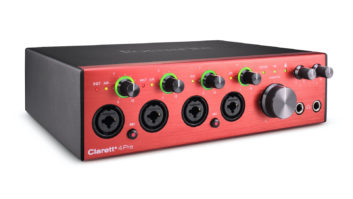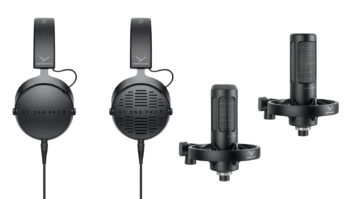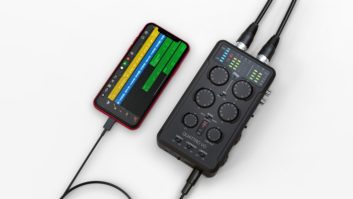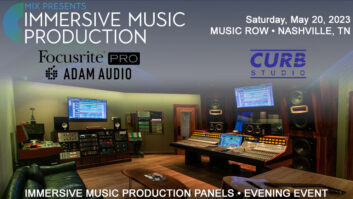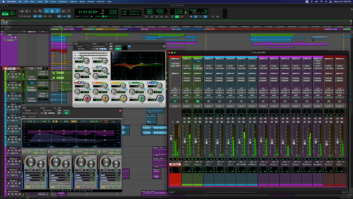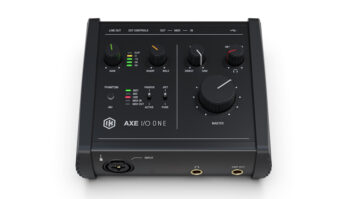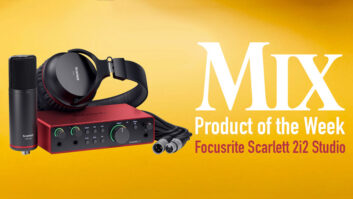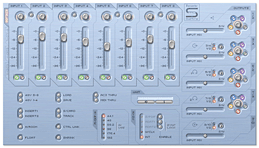
The Focusrite Saffire 2-channel desktop I/O unit that was released in 2006 set the stage for a larger version with more muscle. It didn’t take the company long to create one, and the new Saffire Pro ably picks up where the original unit leaves off.
SaffireControl Pro showing mixer with panning, solo and mute, and monitoring
The Saffire Pro 26 i/o FireWire 400 device is based around a 24-bit/192kHz engine capable of handling 26 channels of inputs and outputs simultaneously. It features eight converters and eight preamps with a pedigree that traces back to Focusrite’s Green Series preamps. The Pro 26 i/o interacts with its computer host using the same intuitive software control in the original Saffire. It also includes plug-in technology borrowed from the company’s Liquid Channel and Forte Suite TDM line, but curiously drops the integrated hardware-side DSP found in the original Saffire in favor of using the computer’s native processing to handle effects.
START YOUR ENGINES
The interface works with all ASIO- or Core Audio-compatible platforms (but not Pro Tools), including my dual-core 3.2GHz Pentium 4 with Steinberg Nuendo 3 as host under Windows XP SP2 and 1.8GHz single-core Mac G5 running Logic Pro Version 7.2 under OS 10.4.9. Focusrite recommends that you run Saffire on its own FireWire bus or card — something I also learned while testing Liquid Mix. Installation was easy on both test systems. With the latest drivers installed and the SaffireControl Pro application running, the interface plugged in and “booted up” immediately.
A PACKED RACK
The 1U front panel, with detachable rack ears for desktop use, sports an anodized finish in an attractive high-tech shade of blue. Channels 1 and 2, nicknamed “super-channels,” each feature an instrument switch for accepting input from guitar, bass, etc., as well as lo-Z buttons for impedance matching. Channel 1 also offers a phase-invert switch. Inputs 5 and 6 may also act as unbalanced inserts on channels 1 and 2, respectively. Phantom power with on/off LEDs can be flipped in banks of four. A master monitoring level control — with dim and mute switch, plus dual ¼-inch headphone out jacks with level controls for separate headphone mixes — round out the connectivity up front.
The back has eight XLR inputs (subordinate to the instrument/line inputs on the front), eight balanced ¼-inch line-level outputs (configurable for surround), two sets of SMUX ADAT I/Os, and co-ax S/PDIF I/O. Also present are MIDI I/O, BNC word clock I/O, dual FireWire 400 ports and a professional-grade screw-in connector for the line-lump power supply. The Pro 26 i/o can be bus-powered using the included 6-pin FireWire cable, so the external power supply is only necessary with computers that have nonpowered 4-pin FireWire connections or cannot supply enough power on their own (such as laptops).
WINDOW TO ITS SOUL

More than the mere “audio setup” panel that you typically get with other interfaces, the SaffireControl Pro software is an elegant and highly advanced mix surface that sits between the hardware and your DAW. All settings and controls that are not physically present on the hardware can be accessed here. It also provides comprehensive custom mix and monitoring solutions, in addition to the preset Tracking or Playback modes.
Mixer features include input-level faders, pan knobs, solo/mute and stereo-link switches for each available channel in a given input mode; output mix controls; and a crossfader that allows you to set the balance of the input mix and the tracks playing back from the sequencer. The outputs can be muted and solo’ed, dimmed by 18 dB in software or padded by 18 dB post-DAC at the interface — a handy tool for calibrating Saffire Pro to extra-hot monitor speakers. A software switch allows the Monitor dial on the hardware to act as a tactile control over the output level.
There are global controls for setting the sample rate and sync source, and an AC3 thru switch allows the S/PDIF Out to transmit an AC3 or DTS signal directly from DVD-playing software to a home surround setup. I appreciated that I could set the control panel to whatever level of complexity was required for a session, and that I could shrink or expand its window. I also liked that it has no annoying drop-down menus.
FLEXING STUDIO MUSCLE
My unit hummed along smoothly without any pops, crackles, drop-outs or lost FireWire signal. Granted, it was almost always the sole sync device during my tests, but was well-behaved when I slaved it to another clock source. What’s especially nice for mixing in smaller rooms is that by engaging the 18dB analog pad, you can work at quieter levels without sacrificing bit-depth at the DAW master fader.
Latency is practically a non-issue, as the unit offers a low-latency hardware monitor that is controlled in software. The actual latency figures (which manifest themselves while playing virtual instruments, for example) vary depending on the power of your computer, available RAM and the DAW buffer size you set. With Nuendo’s buffer set to 256 samples, and 2 GB of system RAM, input latency was 6 ms at 48 kHz, and output closer to 10 ms. Being a Tascam GigaStudio user, I missed not having GSIF driver support.
One thing I noticed when reconfiguring my Logic Pro environment for Saffire’s connections was that SaffireControl Pro hardwires its I/O names to specific channel numbers. For example, if you only wish to use the ADAT facilities, you cannot reconfigure these as channels 1 through 16; the analog channels, even if disabled, are always channels 1 through 8. Though renaming the tracks within your DAW and saving a session/setup template should clear any practical confusion, you’ll need to spend some time reconfiguring I/O settings in existing projects. A far-greater annoyance is making any switching changes (such as turning ADAT banks on/off or changing sample rates); this causes several seconds of delay while physical relays click over in the hardware unit. And this is a cumulative effect — several changes can put your session on hold for 10 seconds or more.
The Saffire Pro’s VST/Audio Units plug-in suite is the same as in the original Saffire, including EQ, compression, amp simulation and reverb. Though simple, they are top-notch in quality, exhibiting no sonic difference from the likes of d2/d3 and Forte Suite plug-ins when I compared similar settings. One feature that I discovered at the very end of the manual is that Saffire Pro can be used in stand-alone mode for use in recording or mixing without a computer.
PRECIOUS GEM
I’m thoroughly impressed with what Focusrite has accomplished here. For the power user, it provides the most I/O connectivity, and to my ears, the best-sounding preamps and converters of any device in its class. The ultra-low-latency 192kHz HD audio sounds brilliant and, when paired with the straightforward control software, can be used to create highly flexible custom monitor mix and talkback schemes that rival those in large-console facilities. The fact that the unit can work in stand-alone mode as a high-quality converter is such a juicy extra that you could purchase one simply for the sound of the Focusrite inputs and exploit any unused ADAT/SMUX ports in your studio. The Saffire Pro 26i/o is also an ideal solution for live sound recordists and mobile users who demand quality sound without the bulk. Price: $999.
Focusrite, dist. by American Music and Sound, 866/FOCUSRITE, www.focusrite.com, www.americanmusicandsound.com.
Jason Scott Alexander is a producer/mixer/remixer in Ottawa, Ontario.
